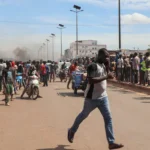The echoes of cries for ‘bread, freedom and social justice’ that dominated the 2011 Arab Uprisings linger only faintly in 2023. Popular calls for better economic prospects and political change across Tunisia, Syria, Libya, Egypt, Yemen and Bahrain have been gradually drowned out by counterrevolutionary forces, authoritarian entrenchment, tepid international responses, violence and misery. And yet, the upheavals of 2011 resurfaced in 2019 with anti-regime protests once more dominating places like Lebanon, Iraq, Iran, Algeria and Sudan.
Protests were different from those of 2011 but also eerily similar. In both cases, large segments of the population showed their dissatisfaction with the social contract[1], in particular the poor performance and stark displays of self-interest of ruling authoritarian elites. A key difference between the uprisings of 2011 and those of 2019 was that those of 2011 were more strongly connected across the region in the symbolic and inspirational sense. This was largely a result of their surprise effect – regimes were not prepared – the amplifying role of social media, Al-Jazeera’s reporting and their use of Arabic as lingua franca. On both occasions, some protests were triggered by socio-economic issues and only turned to calls for regime change when repressed by violence, while other protests demanded the entire political class to leave straightaway. To top it off, both Israeli’s and Iranians took to the streets again in 2022. The former protested the intention of its (extreme) right-wing government to clip the rule of law insofar as it applies to Israeli Jews, whereas the latter demanded wholesale regime change. Finally, it should be noted that a substantial number of MENA countries did not feature major protests akin to those of 2011, 2019, or even 2022. This mostly concerns the Arab countries on the Persian Gulf with the exception of Bahrain, but also Jordan and Morocco.[2] Broadly speaking, demands for change in these countries were more limited due to citizens benefiting from generous welfare arrangements, effective co-optation of the population via state largesse enabled by oil revenues, and ruthless repression.
Revolutionary protests?
Bayat (2017) framed the events of 2011 as ‘revolutions without revolutionaries’. In his view, the Arab Uprisings were bereft of radical new ideas for a political and economic reordering of society away from the neoliberal paradigm. In other words, his criterion for revolution is the extent to which (violent) periods of mass upheaval radically break with existing values, patterns and modalities of socio-economic organization, the nature of rule and the distribution of public resources to uphold both.[3] Lynch (2016) rather cast the Arab Uprisings as a major tipping point in an extended process of grievance accumulation that temporarily breached authoritarian defenses in 2011, but was pushed back by the reactionary forces of co-optation, violent repression and sectarianism.[4] In this view, it is not so much the ‘eruption’ of new ideas that matters, but rather whether popular dissatisfaction can overcome barriers to collective action and reactionary responses. Houry (2018), takes a longer and more constructivist view that considers the Arab uprisings as ‘processes of disruptive practices that are part of a politics of endurance’. In other words, protest events (revolutionary or not) are part of a far longer chain of events and places through which disagreement with existing structures of rule is expressed by citizens, and whose results cannot be assessed in linear fashion, if at all.[5] This traces a continuous line of protest from 2011 to 2019 and 2022 in the expectation of more to follow, even though Houry leaves the nature of the connectedness between these events somewhat ambiguous.
All these frames have their merits as lenses if we view ‘revolution’ as the antithesis of ‘status quo authoritarianism’ that dominated the Middle East before 2011. In Bayat’s take there were no revolutions, only protests. Lynch identified revolutions in Egypt, Syria, Bahrain, Tunisia and Yemen, as well as counter-revolutions all over the region. Houri would likely add Morocco and Jordan as sites where protests occurred as well, even if at lower levels than those of 2011 or 2019. Surprisingly, very few writings consider Islamic State as a revolutionary force, even though it combined violence with a radically different proposition for the organization of society and public authority.[6] This is likely a consequence of the dominance of the Global War on Terror frame.
The performance crisis of authoritarianism
An alternative frame for the protests of 2011, 2019 and 2022 than those outlined above – and potentially a more productive one – is to view them as manifestations of a performance crisis of authoritarian systems across the Middle East and North Africa, irrespective of whether such systems are republican (Syria, Tunisia, Egypt, Turkey), ethno-sectarian (Lebanon, Iraq), clerical (Iran) or monarchical (Jordan, Morocco, Gulf countries) in nature. Mass discontent with limited socio-economic prospects, repressive structures of rule and truncated political rights do not have to lead to revolution in order to cause ruptures in socio-political relations. If one slips into the shoes of the various authoritarians in power in 2011 or 2019, one might have expected protests to have served as wake-up call, indicating it was high time to get out of bed and start improving public goods/services, the quality of governance and perhaps even to subtly redraw some of the boundaries delineating political rights and civil liberties. But such expectations have not materialized as little substantive reform has in fact been initiated, with the exception of modernization projects in some Gulf countries that have a strong socio-economic focus. Instead, authoritarian systems struck back with a vengeance. The result is that pre-2011 authoritarian systems of rule are more entrenched than ever in most countries in the region.[7] In other words, the original problems of political repression, social deprivation and poor economic prospects that triggered protests in 2011 and 2019 have largely been left unaddressed while poorly performing and repressive systems of public authority have reasserted themselves.
A brief tour along the capitals of the regional powers provides ample anecdotic evidence. Riyadh and Abu Dhabi maintained their authoritarian systems without making any political concessions. Instead, they doubled down on top-down socio-economic modernization and co-optation of the masses at home, combined with aggressive support for fellow Arab autocrats abroad (consider Saudi and/or Emirate interventions in Libya, Egypt, Yemen and Jordan). In its turn, Teheran used the past decade to reshape the Levant into an area of Iranian influence despite an unprecedented level of international pressure, mounting domestic protests and growing socio-economic problems back home. Paradoxically, its ‘axis of resistance’ has used the very same methods of oppression that it claims to combat. Turkey’s slow turn to authoritarianism has starkly diminished its role model as democracy infused with Islamic values. Instead, its foreign policy has militarized and it has extended its sphere of influence to include northern Syria, Iraq and Cyprus as well as Libya while becoming more conservative at home. Israel is also turning into a more openly ethno-religious state with power shifting to the conservative-nationalist-extremist right where authoritarian reflexes are strong.
Compounding this mismatch between social crisis and authoritarian continuity is the triple shock of Covid-19, soaring commodity and energy prices and idiosyncratic economic factors such as dysfunctional interest rate management in Turkey, climate change shocks in Iraq, sanctions on Iran, and Saudi Arabia’s poor global reputation. Idiosyncratic factors in particular can be traced back to authoritarianism as system of governance since it allows rulers to pursue their own priorities without full consideration of their impact on the public good from a utilitarian perspective. This ‘triple shock’ comes on top of longstanding regional problems of poverty, inequality, corruption, low productivity, and unemployment – which have been consistently flagged by a long series of UNDP Arab Human Development reports.[8]
All of this points to a significant challenge ahead: the Middle East’s political, social and economic problems that are in dire need of effective public policy responses have increased, while the political systems that should produce and enact such public policies have remained broadly similar, even though their performance record was already poor before 2011. Nevertheless, authoritarian systems are not insensitive to public pressure, opinion and needs, and neither are they suicidal. Rather than pronouncing ‘the death of reform’ on the basis of the limited impact of mass demonstrations over the past decade, the question is what kind of reform might be possible under conditions of authoritarianism. Recent history suggests that authoritarian growth paths are possible and authoritarian systems can initiate successful reforms leading to significant development and growth, albeit temporarily in some cases. Consider South Korea, Singapore, China, Ethiopia until recently, Rwanda and Thailand.
For this reason, it is worthwhile to examine in more detail what factors influence political prospects for reform and renewal across the region under conditions of authoritarianism. By reform, I mean gradual changes in policy and administration that improve basic conditions of life within existing parameters of rule. By renewal, I mean radical changes in governance that override or erase existing parameters of rule. It is likely that gradual changes could be peaceful or would feature limited violence, whereas radical change is bound to be violent under conditions of authoritarianism.
Analyzing prospects for political reform and risks of political renewal
Such analysis must assume that current systems of rule in the Middle East are stable in the short-term because they have a proven capacity to resist both internal and external shocks. Their rulers have made it clear they are willing to go to extreme lengths to remain in power while counterforces tend to be poorly organized, disjointed and often leaderless (in no small part due to effective repression). With this in mind and on the basis of an exploratory literature review, three broad dynamics are likely to influence prospects for political reform and renewal:
- The development orientation of domestic elites, i.e. the disposition of ruling elites to promote national growth.[9] This disposition (or the lack of it) tends to be a function of the nature of a country’s political order (considering factors like the structure of the elite, the economic power structure and sources of elite legitimacy) and its level of administrative effectiveness (including factors like the distribution of coercive capabilities, the role of alternative providers of governance/services, and civil service capability). Elite development orientation determines much of the supply side of reform and renewal although elites can also be active on the demand side of reform. Agreed reform measures are typically executed through the state’s administrative machinery.[10]
- The advocacy strategy for change, i.e. the manner in which demands for reform and renewal are consolidated, expressed and sustained. It is usually enacted by groups that face the consequences of dysfunctional governmental performance. An advocacy strategy for change is the result of dynamics of socio-political mobilization (i.e. how actors overcome collective action barriers) and the nature of demands of change (i.e. its intended results, scope and beneficiaries). The rootedness, longevity and volume of advocacy efforts shape the demand side of reform and/or renewal.
- Foreign pressures that bear on the incentives of a country’s ruling elite to widen or narrow prospects of reform and/or renewal. Such pressures are typically a function of the intensity of foreign engagement (methods range from demarches to military intervention), its coherence (are the P-5 aligned, for example) and a country’s levels of transnational and international dependency (i.e. its sensitivity to pressure). Foreign pressures can interact with supply and demand for reform and renewal, or both.
Each of these broad dynamics can be unpacked in a set of factors and indicators so that a more fine grained assessment grid may be developed. But their outline already offers a useful lens for assessing intersections, gaps and overlaps between the available supply of reform and existing demands for reform. Where overlap is limited, or where the speed of reform that authoritarian systems can manage is too slow, greater mass mobilization, radicalization and revolutionary violence may ultimately follow.
Source: Clingendael
















